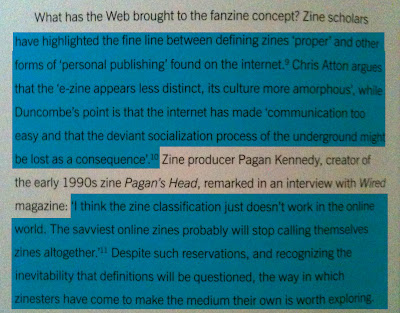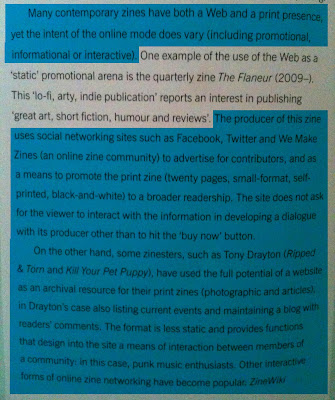It seems that fanzines are still around whether they are created using desktop publishing or made by hand using conventional techniques.
Fanzines are generally flying beneath the radar of mainstream publishing. Distribution takes place at zine fairs, by word of mouth. through independent music stores, bookstores or through the post. They are less concerned about copyright, grammar, spelling, punctuation, page layout, grids and typography.
Moving from 'below critical radar' into mainstream publishing houses was not without its critics or controversy. By 1977, some within the do-it-yourself community were accused of selling out, by trading on the DIY ethos for commercial gain.
Some producers used fanzines as a testing ground before entering into professional careers. Danny Baker, a writer for Sniffin' Glue later was employed by NME and BBC Radio.
Many fanzines have made the jump to mainstream.
Fanzines are a 'novel form of communication' - a unique place in the history of communication. They exist as genuine human voices outside of all mass manipulation.
With the rise of computers in the 1980's, producers began to use desktop publishing packages to generate their texts and layouts. Advances in technology over the last few years have also changed how we view fanzines with online or digital forms.
Larry Bob described the zine 'as a labor of love, producing no profit, and frequently a loss, of time at least.'
Many fanzines like Beggar's Banquet were discarded and nobody was interested in it. It took months to distribute causing a loss of money and time.
The fanzine - non-commercial, unofficial, amateur publications that are politically self-conscious and can form an important communication network for alternative cultures.
The DIY charm is at stake due to zines moving from the underground into a more mainstream consciousness.
Many fans considered the fanzines to be the only reliable way of disseminating information.
Through the process of resistance, subcultures were freed from the limits and constraints of the dominant culture - 'Cultural Resistance' - represented through content or graphics. This helps to establish a community of like-minded individuals.
Fanzines became vehicles of subcultural communication and played a fundamental role in the construction of punk identity and a political community.
As fanzines and their producers became absorbed into consumer culture and the mainstream -whether through book deals or by appearing on television or radio - questions around 'selling out were debated.
Hardly a days go by without logging on and off looking at websites for news and checking out social networking sites for many people. Online publishing has produced cheaper forms of printing and distribution.
Digital medium is immediate, inexpensive and widely available.
By 1992, it was eveident that an e-zine community was emerging.
Zines are not targeted towards a mass audience and are generally not made to make a profit. As technology moved forward, so did the way in which zinesters used the medium. The coming of a new browser called Netscape Navigator in 1994 made information on the web become more accessible, prompting a new generation of web-based e-zines.
Chris Atton argues that the 'e-zine appears less distinct, its culture more amorphous.' while Duncombe's point is that the internet has made 'communication too easy and that the deviant socialisation process of the underground might be lost as a consequence."
Pagan Kennedy: 'I think the zine classification just doesn't work in the online world.'
The web is sometimes just used for promotional or interactive aspects of the printed presence.
Facebook, Twitter and We Make Zines are used to advertise to broaden the readership. SOme have used the full potential of a website as an archival resource for their print zines.
Zine Library is an open publishing site where users can upload and download pdf versions of zines.
This extract shows a great difference between blogs and fanzines.
Fanzines used to be published on an irregular basis and producers found it hard to receive feedback at speed. There is ease and speed of how a blog can be accessed versus the old-stlye method of sending off for something in the post - there is a different connection between reader and producer now.
Some producers have merged the original aesthetics of fanzines with online.
There is an increase in online interaction the more that e-zines continue to develop especially with the advance of ever-more portable computer devices.
Anti e-zine sentiment exists: "no annoying link bullshit, you just turn the page." Some print purists argue that you can't have a zine fair in cyberspace. E-zines have facilitated some of the best work in the field: but the death of print is evidently greatly exaggerated.
ZIne fairs are still extremely popular which is something that some argue cannot happen in cyberspace. However, it seems that the Internet helps promote them.



























































Thanks !! Very helpful for my college work on fanzines
ReplyDelete